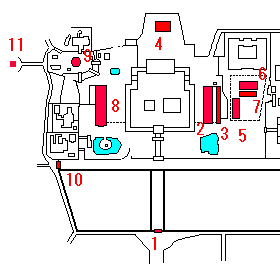| No. |
Picture | Name | Description |
|---|
1 |
 | Nandaimon | South Main Gate:
National treasure
This gate is the main gateway into Horyuji. It is said, originally,
the gate was built together with the Central gate and the location of the gate had been
nearer to the Central gate. In 1031, the original South Main gate was relocated at
present position, but it was burnt down in around 1434 and restored in 1438, keeping
original architectural style. |
2 |
 | Shoryo-in, Higashimuro | Hall of
Prince Shotoku's Soul and east dormitory: National treasure
Originally, this building
might have been constructed for dormitory of 9 rooms for monks. However, the front
portion (3 rooms) of the building was reformed as Hall of Prince Shotoku's soul for
enshrining the prince statue in around 1121. In 1284, the building was re-erected,
separating the Hall of Prince Shotoku's soul and east dormitory. |
3 |
 | Tsumamuro | Dormitory for lower
rank monks: Important cultural asset
(See below) |
4 |
 | Kami-no-Midoh | Inner Sanctuary:
Important cultural asset
Originally, this hall was built by "Toneri-Shinnou" (676-735)
who was the third son of the Emperor Temmu and chief editor of "Nihon-Shoki" (Chronicle of
Japan). Present hall was rebuilt in 1324. It houses many Buddha statues. |
5 |
 | Kohfuzoh | The original treasure house for
the temple: National treasure
Built in the log-cabin style, it consists of two units
joined under one roof and raised above the ground to permit for air circulation.
Many
religious arts displayed in the Gallery of Temple Treasures today had been stored here until
the former Gallery was erected in April 1941. |
6 |
 | Jikidoh | Dining Hall: National
treasure
(See below) |
7 |
 | Hosodono | Related facility of the
Dining Hall: Important cultural asset
(See below) |
8 |
 | Sangyoh-in, Nishimuro | Three sutra Hall and
west dormitory: National treasure
Originally, this building might have been constructed
for dormitory for monks as well as east dormitory, built at the position symmetrically
centering the heart of the western precinct. Original building was burnt down in around
1080. At the re-erection in 1231, the building was relocated at the current position and
divided rear portion of the building as west dormitory and front portion as Three Sutra Hall
for the memory of Prince Shotoku who lectured three different sutras. |
9 |
 | Saiendo | West Round (actually Octagonal) Hall:
National treasure
It is also called the Mine-no-Yakushi, Healer of the Hill, since the
hall has a Yakushi as its main image. |
10 |
 | Saidaimon | West Gate
Originallly, this gate
was erected in 1030s, but re-erected in 1697. |
11 |
 | Monument of Dr. Langdon Warner | Dr. Langdon
Warner (1881-1955) was an American scholar of oriental arts at Harvard University. He was
mistakenly believed by the Japanese that during the World War II, he advised the US
Government not to destroy Kyoto and Nara by air-raid for protecting cultural assets of Japan.
( It was US Secretary of War Henry Stimson who was responsible for sparing these cities.)
Before and after the war, he visited the temple many times. The right side tomb is of Mr.
Takurei Hirako (1877-1911), a researcher of Horyuji. |




